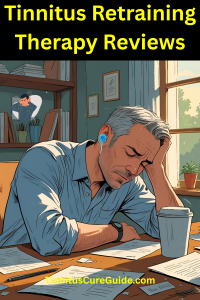Tinnitus Retraining Therapy Reviews: Does It Really Work?
Living with tinnitus can feel overwhelming. That constant ringing, buzzing, or whooshing in your ears isn’t just distracting—it can affect sleep, concentration, and even your mood. Many sufferers spend years searching for relief, trying everything from sound machines to supplements. One treatment that has gained attention in the U.S. is Tinnitus Retraining Therapy (TRT). But does it really work? In this article, we’ll break down tinnitus retraining therapy reviews, explore how the therapy works, and give you an honest look at the pros, cons, and real-life experiences of people who have tried it.
What Is Tinnitus Retraining Therapy (TRT)?
Tinnitus Retraining Therapy, developed in the 1990s by Dr. Pawel Jastreboff, is a long-term treatment designed to reduce the perception of tinnitus. Unlike quick fixes, TRT combines sound therapy with counseling to retrain the brain to ignore ear ringing.
Key components include:
-
Counseling sessions – Patients learn about tinnitus, how the brain processes sound, and techniques to reduce anxiety.
-
Sound therapy – Low-level sounds from hearing aids, sound generators, or white noise devices are used to mask tinnitus and promote habituation.
-
Gradual retraining – Over time, the brain reclassifies tinnitus as an unimportant sound, similar to how we tune out background noises.
How Does TRT Differ From Other Tinnitus Treatments?
-
Masking devices only cover up tinnitus temporarily, while TRT aims to change how your brain perceives it.
-
Medications may ease stress, but don’t directly treat tinnitus.
-
Cognitive Behavioral Therapy (CBT) focuses on emotional response, while TRT combines counseling with sound exposure.
👉 The unique advantage of TRT is that it doesn’t try to eliminate tinnitus but instead helps patients habituate to it—meaning they notice it less over time.
Tinnitus Retraining Therapy Reviews: What Patients Say
When looking at tinnitus retraining therapy reviews, you’ll find a mix of experiences:
Positive Reviews
-
Many patients report a significant reduction in distress after 6–12 months of therapy.
-
Some say they hardly notice their tinnitus anymore, especially during the day.
-
Others note improvements in sleep quality and stress management.
Mixed or Negative Reviews
-
TRT requires commitment and patience—results may take 12–24 months.
-
The cost can be high in the U.S., often ranging from $2,000 to $5,000, depending on the clinic and duration.
-
Not everyone responds—about 20–30% of patients report little or no improvement.
Success Rates of TRT
According to published studies and U.S. clinical data:
-
60–80% of patients report noticeable improvement in tinnitus perception.
-
Benefits often increase the longer therapy continues.
-
Success is higher in people who follow both the counseling and sound therapy consistently.
👉 While not a guaranteed cure, TRT has one of the strongest evidence bases among tinnitus treatments.
Pros and Cons of Tinnitus Retraining Therapy
Pros
-
Non-invasive and drug-free
-
Supported by research
-
Can significantly reduce distress and improve quality of life
-
Helps retrain the brain rather than just masking symptoms
Cons
-
Expensive, not always covered by insurance
-
Requires long-term commitment (12–24 months)
-
Results vary between individuals
Who Is a Good Candidate for TRT?
TRT may work best if you:
-
Struggle with chronic tinnitus that affects your daily life
-
Are motivated to commit to long-term therapy
-
Have tried other tinnitus remedies without success
It may not be ideal if you’re looking for instant relief or can’t commit financially to ongoing sessions.
Alternatives to TRT
If TRT feels overwhelming or out of reach, other options include:
-
Cognitive Behavioral Therapy (CBT) – Teaches coping strategies to reduce tinnitus-related anxiety.
-
Hearing aids for tinnitus – Dual-function devices that amplify sound while masking ear ringing.
-
Sound masking devices – White noise machines or apps for night-time relief.
-
Natural tinnitus treatments – Stress reduction, dietary changes, and supplements like magnesium or zinc.
-
Lifestyle changes – Limiting caffeine, alcohol, and noise exposure to reduce triggers.
Real-Life Coping Strategies Shared in Reviews
Beyond professional therapy, tinnitus sufferers in the U.S. often share personal coping tips in reviews:
-
White noise at night to prevent focusing on ear ringing while trying to sleep
-
Mindfulness and meditation to calm the nervous system
-
Exercise to improve circulation and reduce stress
-
Diet adjustments—avoiding too much salt, caffeine, or alcohol
-
Ear protection at concerts or noisy work environments to prevent worsening symptoms
These small changes, when combined with structured therapy like TRT, can make a noticeable difference.
FAQs About Tinnitus Retraining Therapy Reviews
1. How long does tinnitus retraining therapy take to work?
Most patients report improvement within 6–12 months, though full habituation can take up to 18–24 months. Reviews often highlight gradual progress, with steady reductions in distress and improved quality of life over time.
2. Is TRT covered by insurance in the U.S.?
Insurance coverage is limited. While some plans may partially cover counseling sessions, sound generators, and hearing aids are rarely included. Reviews frequently mention that many patients must budget out of pocket for TRT programs.
3. Can TRT cure tinnitus completely?
TRT does not cure tinnitus but helps retrain the brain to filter out the ringing. Reviews emphasize that the sound becomes less intrusive and distressing, allowing patients to live more comfortably without constant focus on the noise.
4. How much does tinnitus retraining therapy cost?
The cost of TRT in the U.S. typically ranges from $2,000 to $5,000, depending on provider and program length. Patient reviews often note the investment is worthwhile when long-term improvements in quality of life are achieved.
5. Are there risks or side effects of TRT?
TRT is considered safe and non-invasive. The primary drawback is the financial and time commitment, as reviews stress the need for patience. No physical risks are reported, making it a low-risk tinnitus management option.
6. Who should not try TRT?
People expecting a quick cure or unwilling to commit to long-term therapy may find TRT frustrating. Reviews suggest it’s best for motivated patients ready to follow consistent counseling and sound therapy guidance over months or years.
7. How do tinnitus retraining therapy reviews compare to CBT reviews?
Reviews indicate both therapies are effective, but with different approaches. CBT helps patients manage emotional responses to tinnitus, often offering faster relief. TRT focuses on long-term habituation, with many reviews noting more enduring improvement over time.
Tinnitus Retraining Therapy Reviews – Conclusion
When reading tinnitus retraining therapy reviews, it’s clear that while not a miracle cure, TRT offers real hope for many people dealing with constant ear ringing. The therapy requires patience, consistency, and investment, but for those who commit, it can dramatically reduce the distress of tinnitus.
👉 If tinnitus is disrupting your daily life, consider discussing TRT with a hearing specialist or audiologist. It may not silence the ringing completely, but it can help you take back control and live with more peace of mind.
Disclaimer
This article is for informational purposes only and should not be taken as medical advice. Always consult with a licensed healthcare professional or audiologist before beginning any tinnitus treatment.






